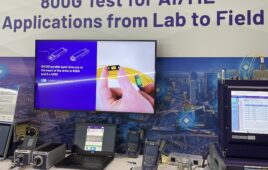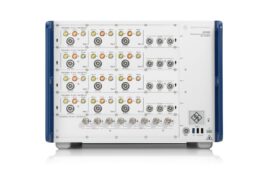The M9484C VXG signal generator from Keysight supports up to four independent channels for testing 5G and satellite receivers.
 When designing new and emerging technologies, you often need test equipment that’s a step ahead of the technology you’re developing. Given the complex OFDM modulations used in 5G radios, you need to accurately generate those signals when testing receivers. Keysight’s M9484C VXG signal generator lets you create calibrated signals with minimal noise and harmonics.
When designing new and emerging technologies, you often need test equipment that’s a step ahead of the technology you’re developing. Given the complex OFDM modulations used in 5G radios, you need to accurately generate those signals when testing receivers. Keysight’s M9484C VXG signal generator lets you create calibrated signals with minimal noise and harmonics.
The M9484C uses direct-digital synthesis (DDS) technology and DSP to generate those signals. DDS has long been used in lower frequency arbitrary waveform generators and signal generators. According to Keysight, the DDS eliminates signal impairments caused by a traditional analog I/Q modulator, such as gain
imbalance, timing skew, quadrature skew, DC offset and phase noise. This new architecture improves a signal’s dynamic range and offers advanced signal fidelity, especially for wideband signal generation.
Using its DSP ASIC, the M9484C can emulate up to 8 baseband signals per channel, aggregating them into a single wideband
signal in real time. It provides flexible, real-time manipulation of baseband signals, where each baseband signal can be independently controlled, filtered, faded and placed anywhere within a 2.5 GHz bandwidth in real time.
With the M9484C, you can generate signals at carrier frequencies up to 54 GHz, depending on model, and up to 110 GHz with an optional frequency extender. The table shows the models and frequency options in the M9484C series.
| Option | CW Frequency Range | output connector |
| M9484C-506 | 9 kHz to 6 GHz | Type-N (f) |
| M9484C-508 | 9 kHz to 8.5 GHz | Type-N (f) |
| M9484C-514 | 9 kHz to 14 GHz | 3.5 mm (m) |
| M9484C-520 | 9 kHz to 20 GHz | 3.5 mm (m) |
| M9484C-532 | 9 kHz to 31.8 GHz | 1.85 mm (m) |
| M9484C-544 | 9 kHz to 44 GHz | 1.85 mm (m) |
| M9484C-554 | 9 kHz to 54 GHz | 1.85 mm (m) |
Each model is available with one, two, or four channels. The instruments feature several options that include output power, spectral purity, I/Q modulation, error-vector magnitude (EVM), and arbitrary waveform memory (256 MSa to 4096 MSa). The M9484C’s RF bandwidth goes up to 2.5 GHz.
Each output channel covers all 5G NR frequency bands and supports signals for beamforming and MIMO. A touchscreen user interface lets you select and configure test signals. The instrument also works with Keysight’s Pathwave signal-generation software.
The video below shows a demonstration of the M9484’s DDS signal generation.




Tell Us What You Think!